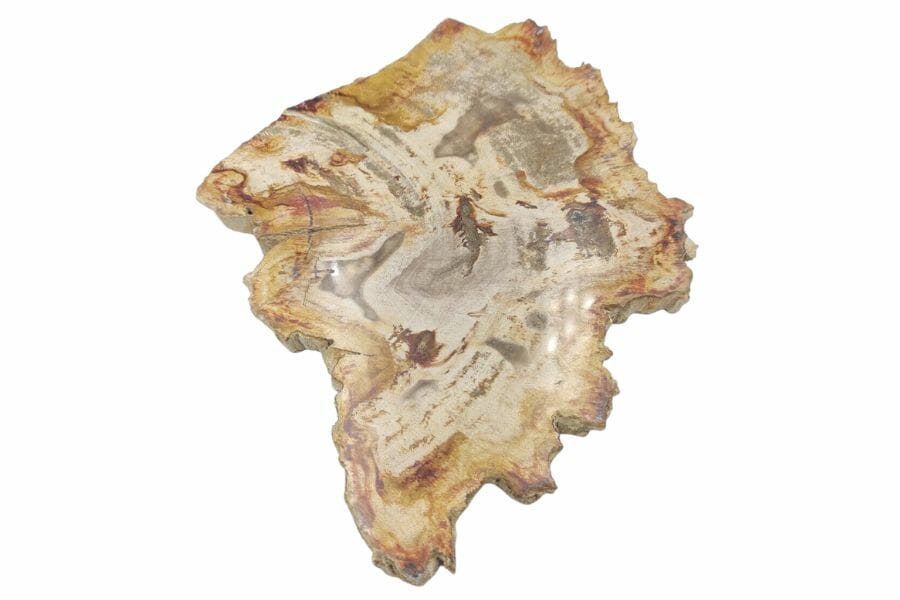Exploring the state’s rugged terrain offers a unique opportunity to discover petrified wood, a fossilized treasure from ancient forests. With the right tips, you’ll be ready to embark on your own adventure and uncover these fascinating remnants of prehistoric life.
Knowing where to look and what to expect will increase your chances of spotting these remarkable pieces scattered across this great state’s terrain!
Petrified wood you can find in the US
In the United States, several types of petrified wood can be found, each with unique characteristics based on the original tree species and the minerals involved in the fossilization process. Here are some of the types you’ll be able to find.
Araucarioxylon
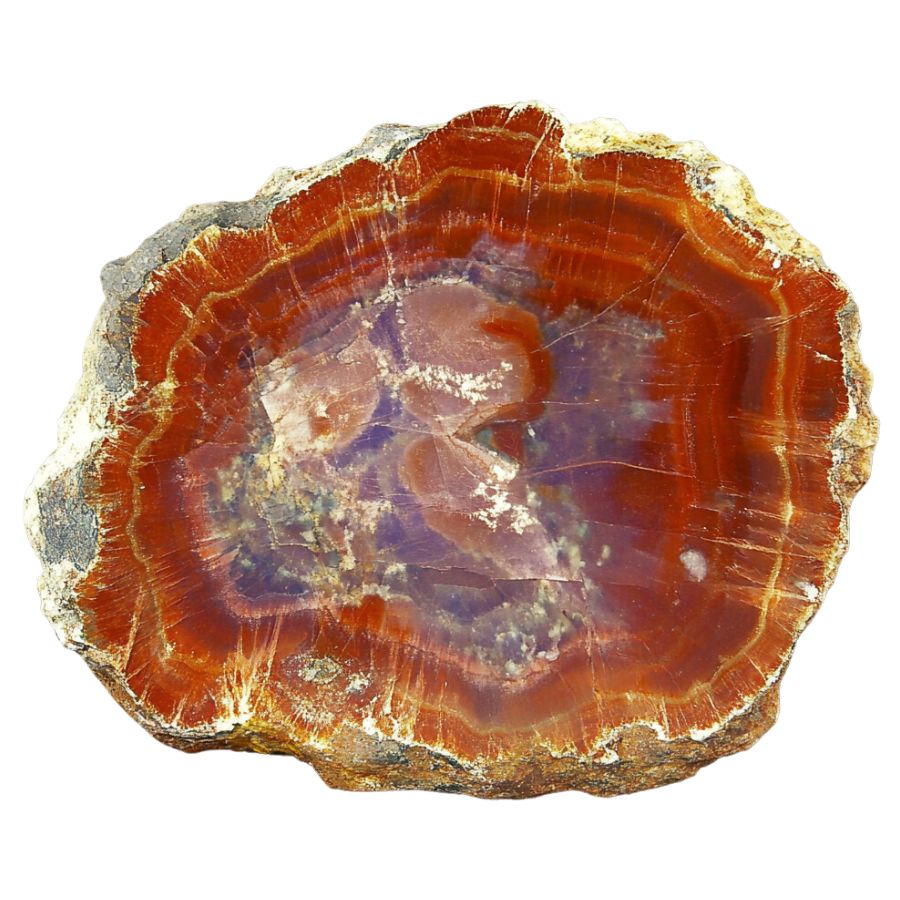
Found in the Petrified Forest National Park in Arizona, this is one of the most famous types of petrified wood. It comes from an extinct species of conifer. As Arizona’s state fossil, Araucarioxylon holds a special place in the state’s natural history.
These trees once formed vast forests during the Late Triassic period, about 225 million years ago. The vibrant colors in this petrified wood come from minerals that replaced the original tree material over time.
Metasequoia
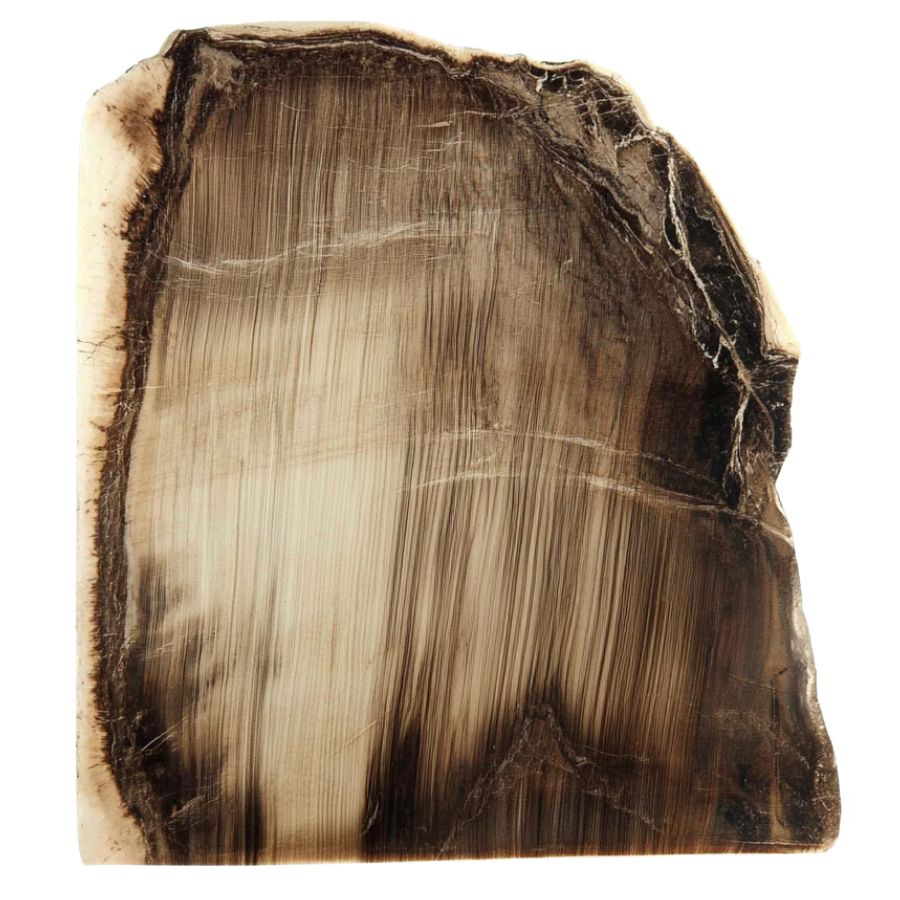
Often referred to as dawn redwood, this type of petrified wood can be found in various parts of the U.S., including the Pacific Northwest. Metasequoia was once thought to be extinct until living trees were later discovered in China.
Furthermore, its fine grain and reddish-brown color are characteristic features.
Palmoxylon
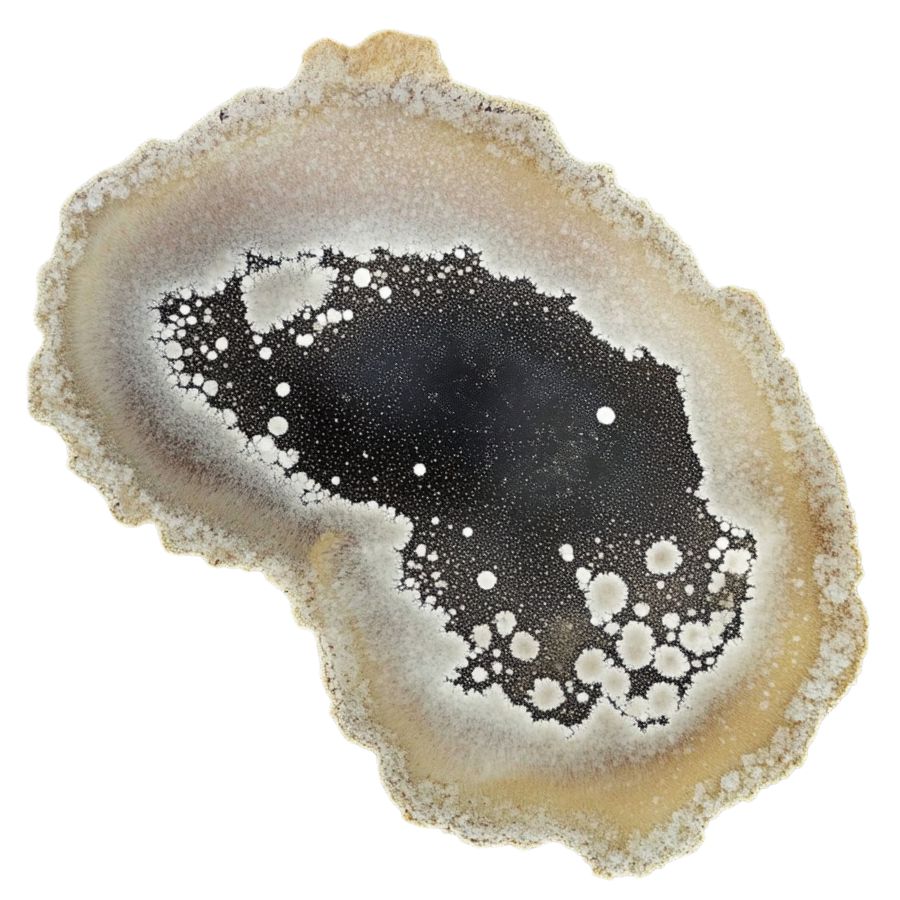
This petrified wood originates from palm trees and is often found in the Gulf Coast states like Texas and Louisiana. Recognized as the state stone of Texas, Palmoxylon is abundant and holds cultural significance.
The wood’s unique speckled or dotted pattern comes from the vascular bundles of the original palm tree. These fossils date back to the Cretaceous period, when the area was tropical and teeming with life.
Taxodium
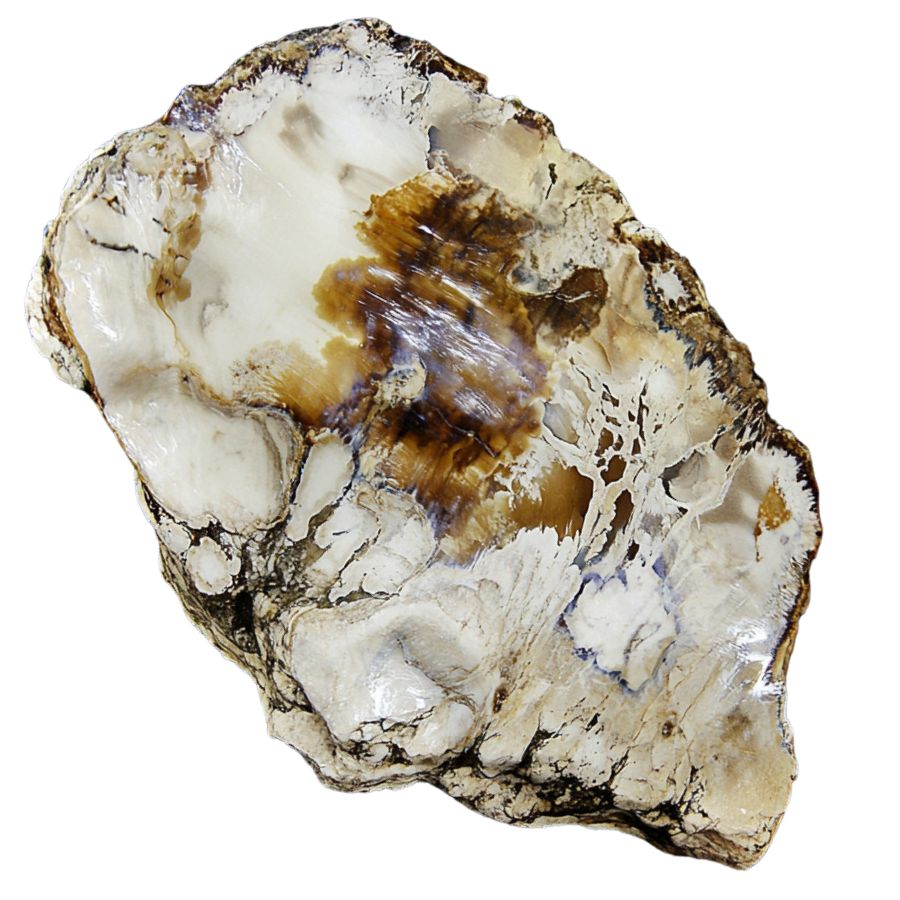
Also known as bald cypress, this petrified wood can be found in the southeastern U.S., particularly in areas that were once swampy. Taxodium wood is often found in places that were ancient swamps, where these trees thrived millions of years ago.
The wood is durable and shows intricate grain patterns, with growth rings and knotholes that tell the story of its long history. It’s a fascinating glimpse into the wet environments that once dominated the Southeast.
Sequoioxylon
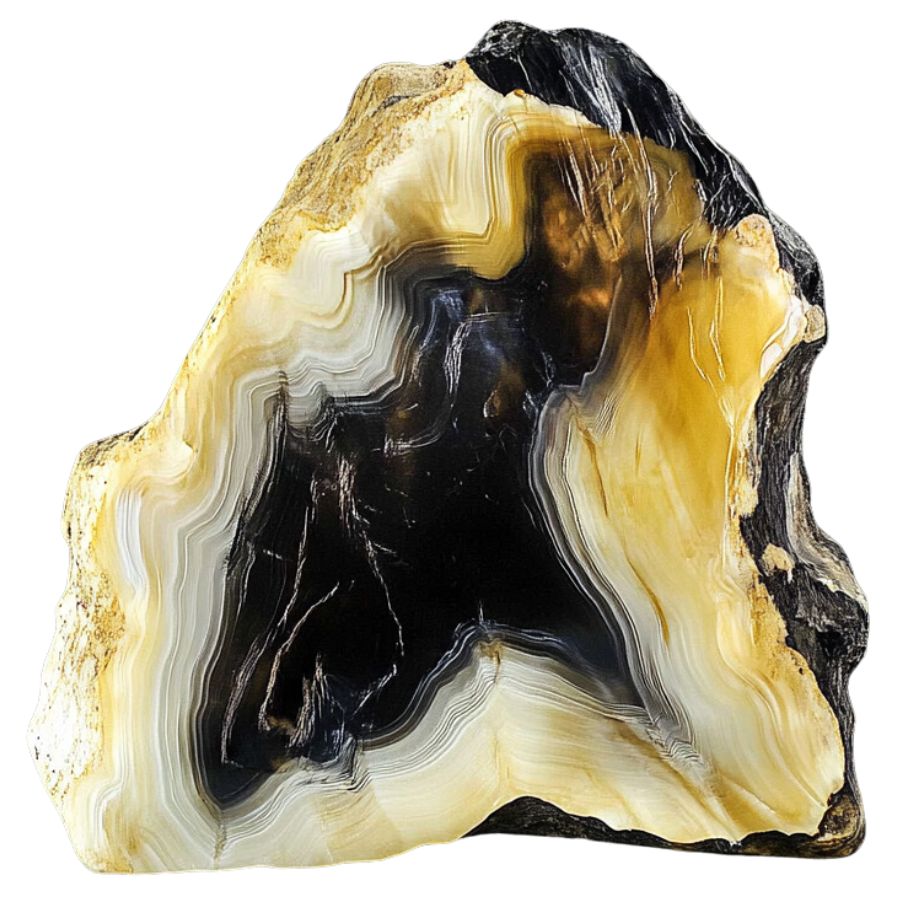
Petrified wood from ancient sequoia trees, found in places like California, where sequoia forests once thrived. These trees are the ancestors of the giant sequoias that still stand in California today.
The petrified wood is notable for its large, straight grain and reddish color, reflecting the immense size and age of the original trees.
Ginkgoxylon
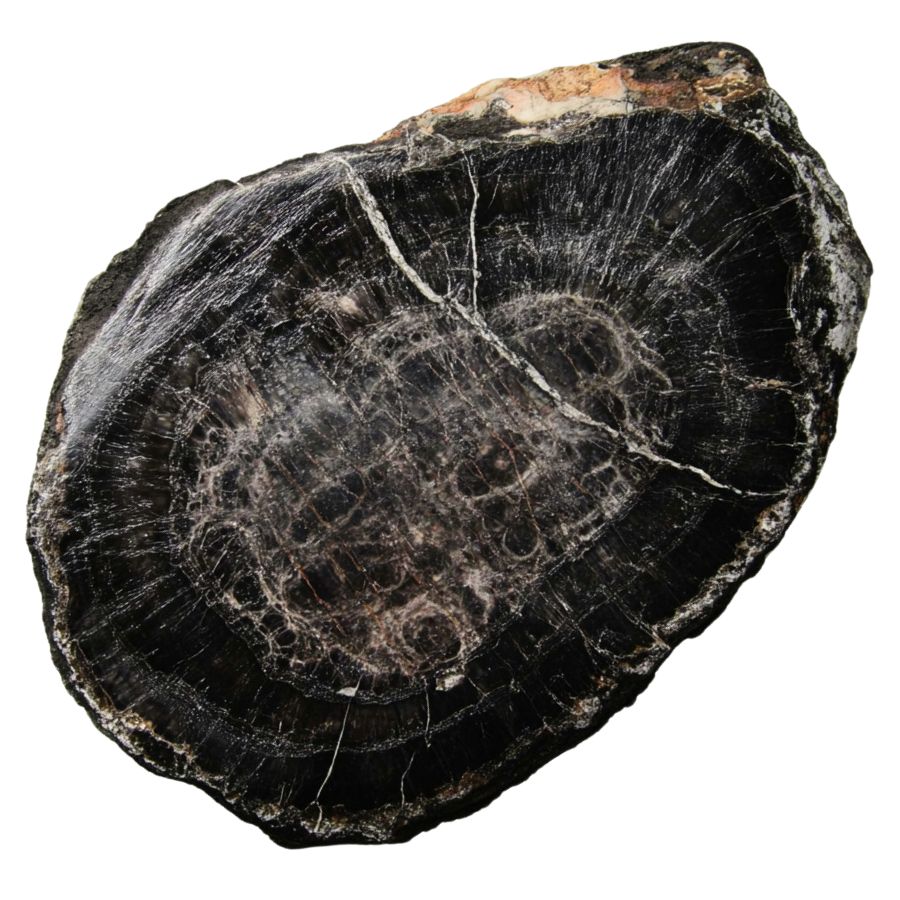
Petrified wood from ancient ginkgo trees, which can sometimes be found in states like Oregon and Washington. Ginkgo is one of the oldest tree species on Earth, with fossils dating back over 200 million years.
Ginkgo petrified wood often has a light color and may show patterns similar to the fan-shaped leaves of the living ginkgo.
Dicotyledonous Wood
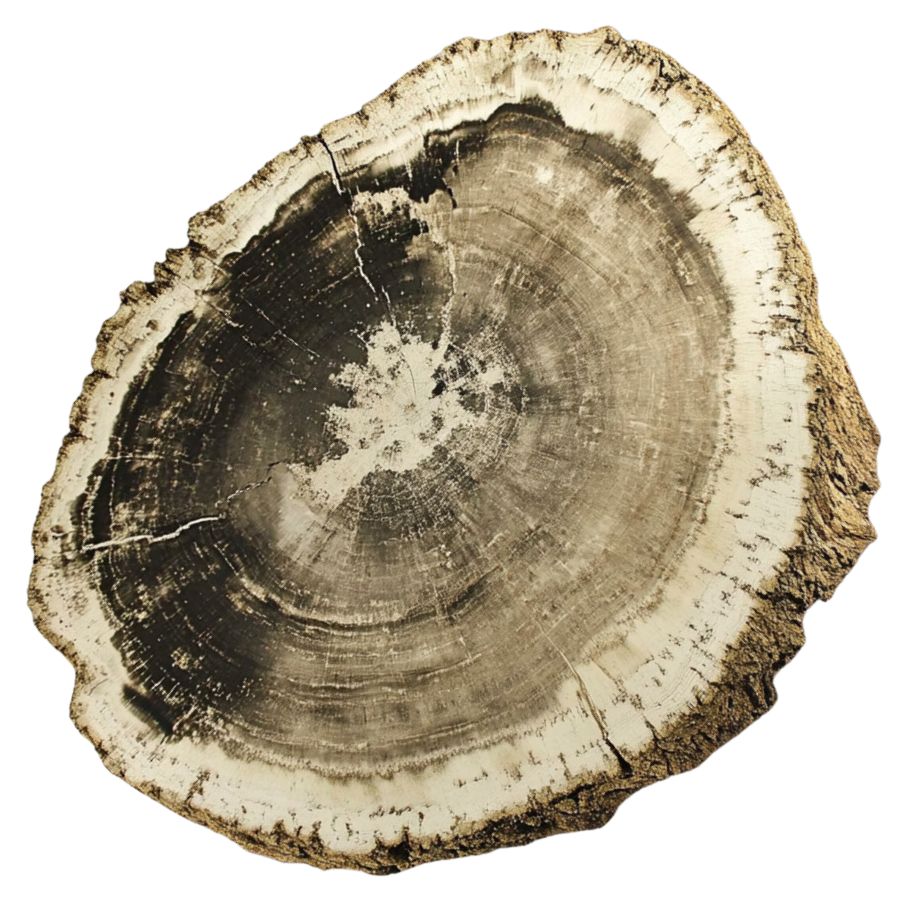
Found across various states, this type of petrified wood comes from broadleaf trees, making it more common and varied in appearance. You can spot dicotyledonous wood by the distinct vessels and growth rings that indicate seasonal changes.
This type of petrified wood is often found in regions that were once temperate forests, offering clues about the diverse plant life that existed millions of years ago.
Piceoxylon
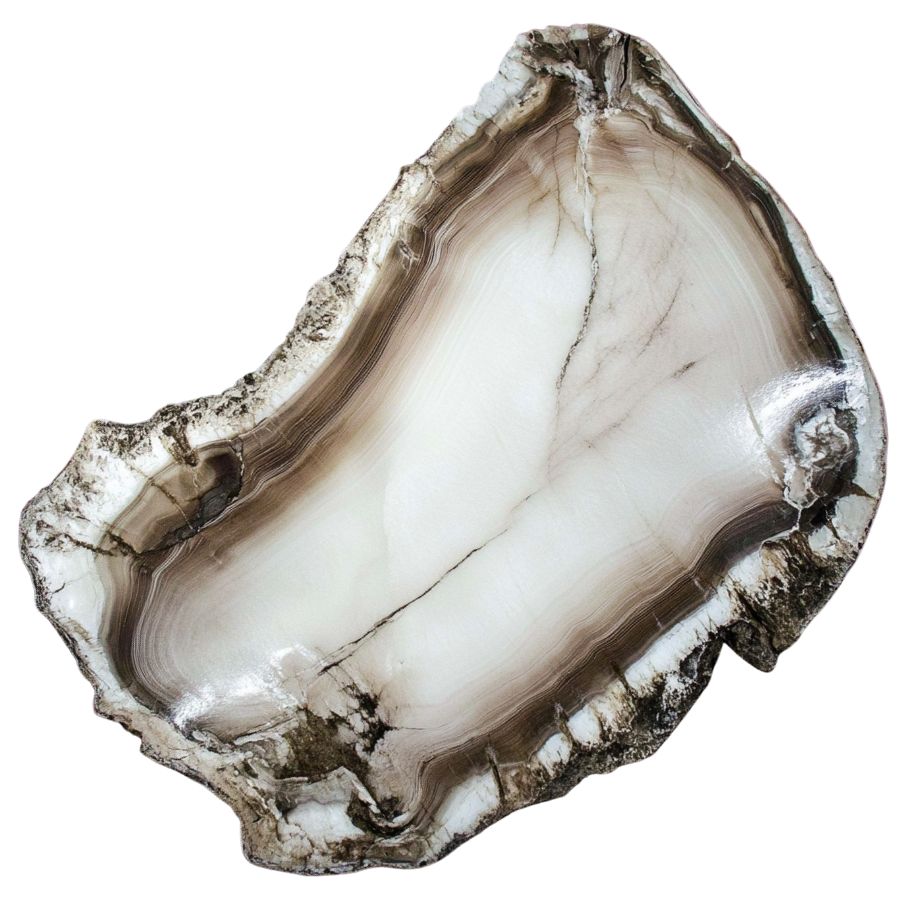
Petrified wood from ancient spruce trees, commonly found in areas like Wyoming and Montana, where coniferous forests once thrived. Piceoxylon is known for its straight grain and pale color, often showing growth rings that tell the tree’s life story.
These trees were part of the ancient boreal forests that covered large parts of North America during cooler periods.
A Quick Request About Collecting
Always Confirm Access and Collection Rules!
Before heading out to any of the locations on our list you need to confirm access requirements and collection rules for both public and private locations directly with the location. We haven’t personally verified every location and the access requirements and collection rules often change without notice.
Many of the locations we mention will not allow collecting but are still great places for those who love to find beautiful rocks and minerals in the wild without keeping them. We also can’t guarantee you will find anything in these locations since they are constantly changing.
Always get updated information directly from the source ahead of time to ensure responsible rockhounding. If you want even more current options it’s always a good idea to contact local rock and mineral clubs and groups
What Rough Petrified Wood Looks Like
Most of the photos you find of petrified wood are pieces that have been cut and polished. That is certainly useful but isn’t super helpful once you are out in the field. This is what you should look out for once you start hunting:
Exteriors like this
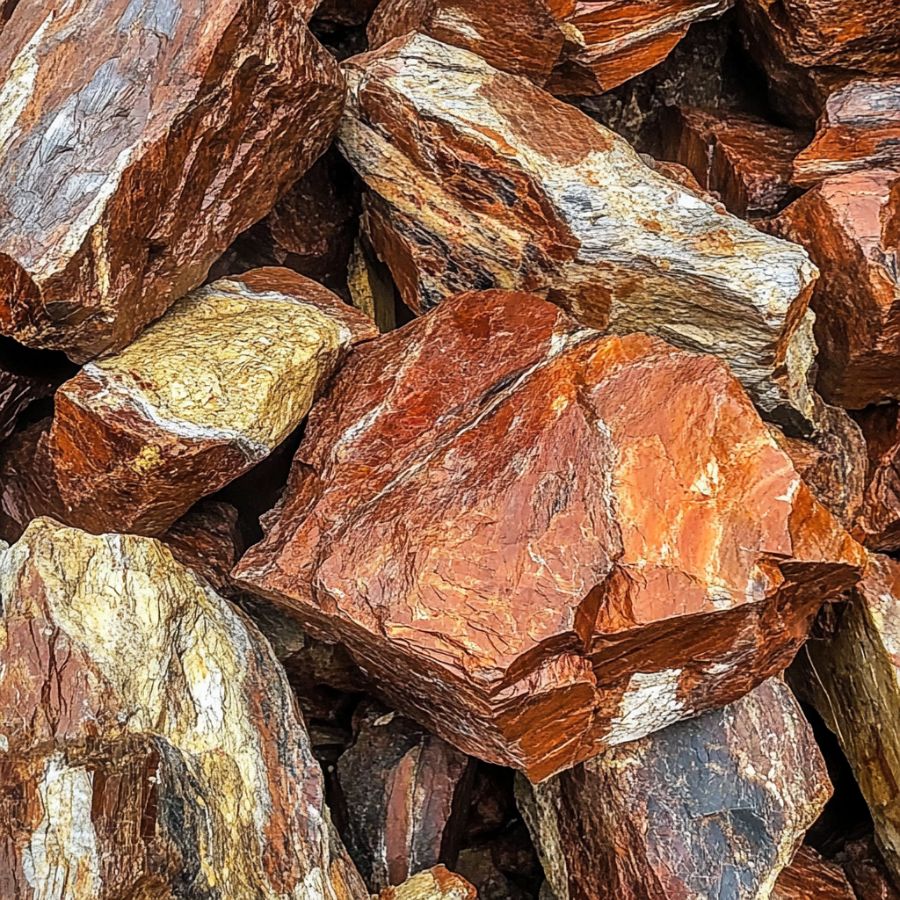
Every type of petrified wood has a different exterior and pattern but this is a good starting point on what to look for.
Texture and grain patterns
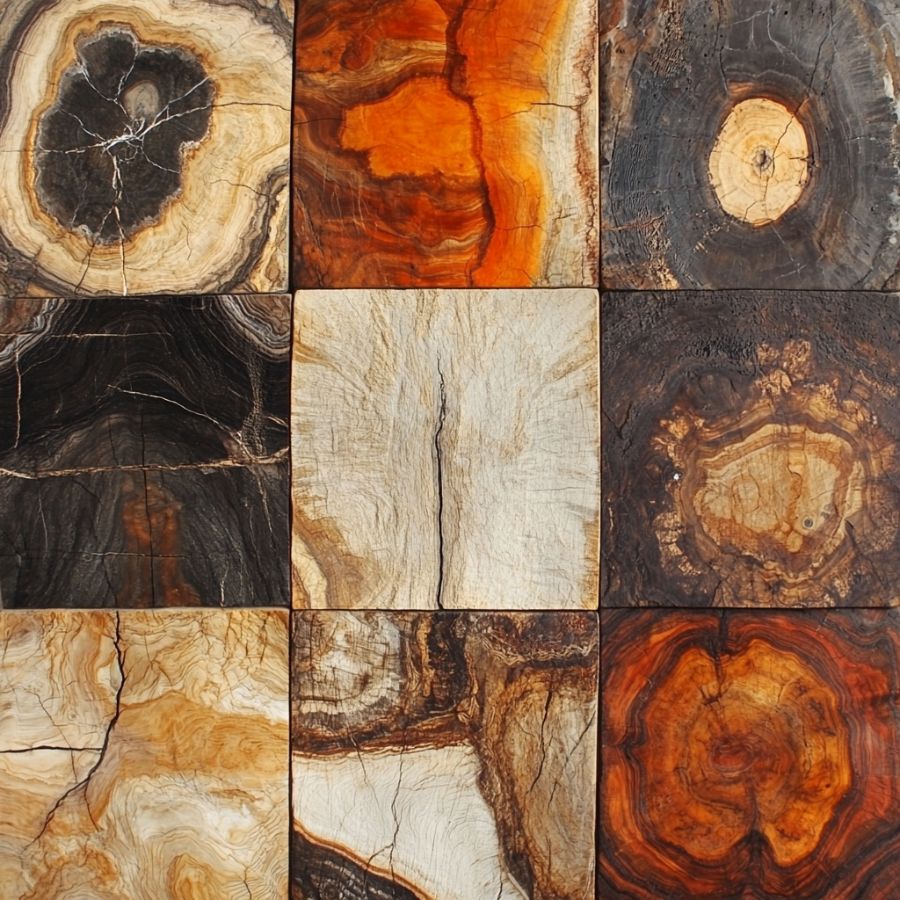
One of the most distinctive features to look for is the texture and grain patterns. Petrified wood often retains the original structure of the tree, including the grain, knots, and even growth rings. These patterns can appear similar to modern wood but are typically more rigid and fossilized.
Examine the surface for any linear patterns or striations that indicate the original wood grain. The texture may feel smoother or more polished in certain areas where mineralization has created a glassy effect.
Coloration and mineralization
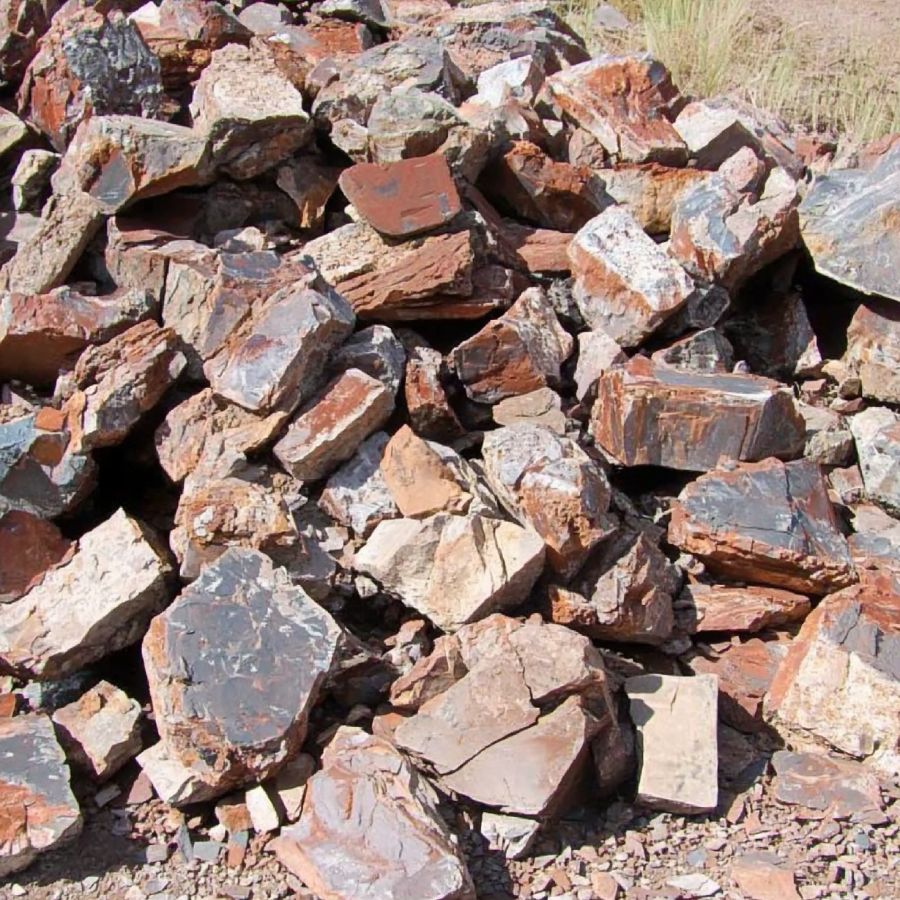
The color of petrified wood can vary significantly due to the minerals that replaced the organic material during the fossilization process. Common colors include shades of brown, red, yellow, orange, and black.
Some pieces might even exhibit multiple colors in intricate patterns. These colors are often more vivid and diverse than those found in regular rocks. When inspecting potential petrified wood, look for these distinct and varied hues, which can indicate the presence of different minerals such as silica, iron, manganese, and others that contributed to the petrification process.
Bark and exterior features
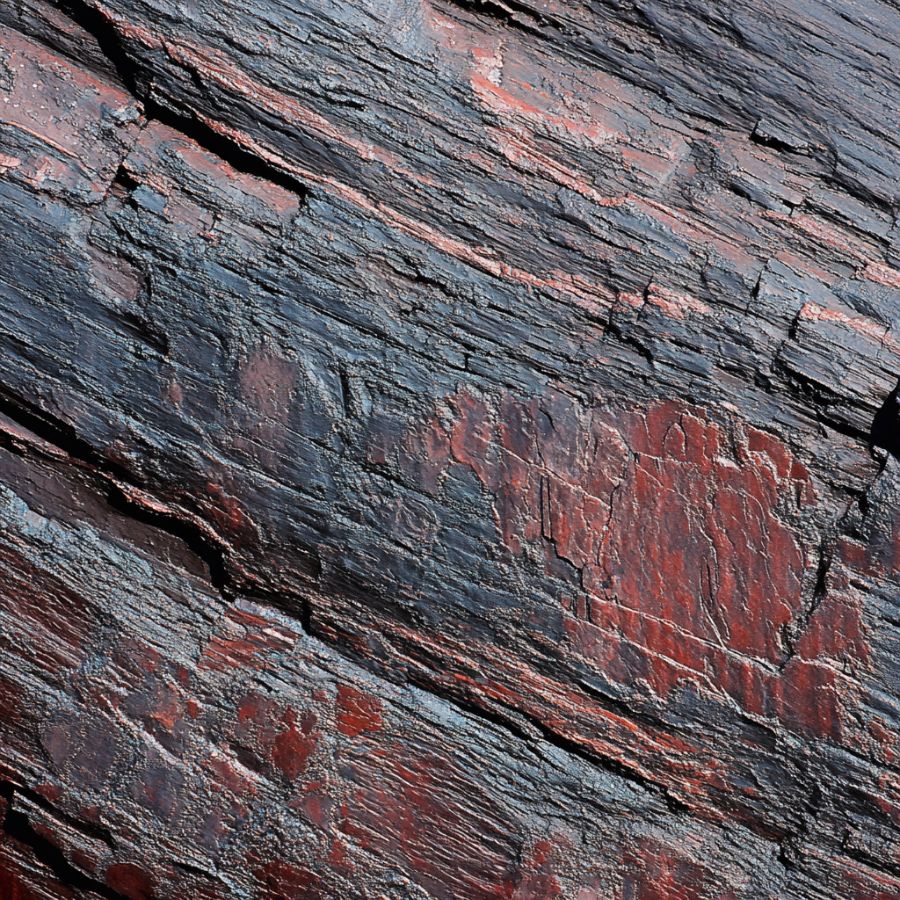
Another telltale sign of petrified wood is the presence of bark impressions or external textures that resemble tree bark. These features are often well-preserved and can include the rough, fibrous texture of bark, knots, or other surface irregularities typical of natural wood.
The exterior of rough petrified wood may also have a weathered appearance, with cracks and fractures that occurred as the wood fossilized over millions of years. Look closely for these natural wood features, as they can be a strong indicator that you have found a piece of petrified wood.
Weight and density
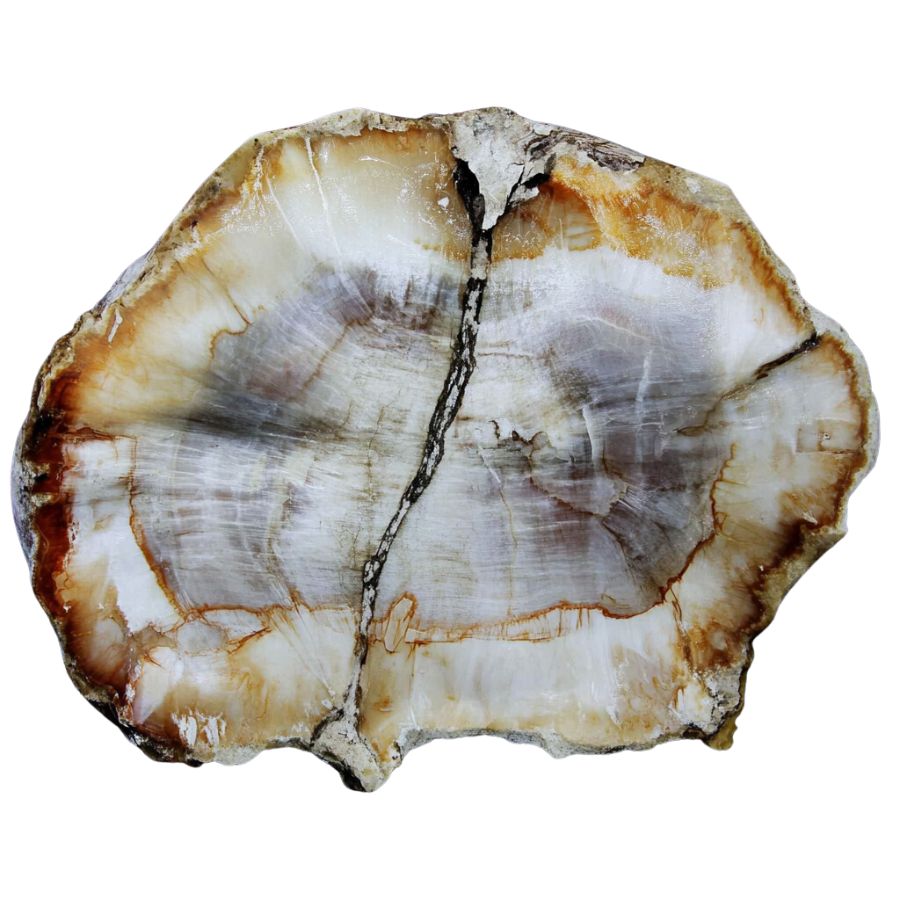
Petrified wood is typically much heavier and denser than regular wood due to the mineralization process. When rockhounding, pick up the specimen to feel its weight. Even small pieces of petrified wood will feel significantly heavier than an equivalent-sized piece of non-fossilized wood.
This increased density is due to the replacement of organic material with minerals, making petrified wood feel more like a rock than wood. Comparing the weight and density of your find with known samples of petrified wood can help confirm its authenticity.
- The extensive local experience of our team
- Input from a variety of local rockhounds and rockhound groups
- The difficulty in accessing a location
- Safety and potential hazards when collecting
- Private and public locations
- A desire to include locations for both the experienced and newbie hunters who are just starting out
Using these inputs we think we’ve put together the best list out there for those who love finding petrified wood for our collections!
General Areas To Try First
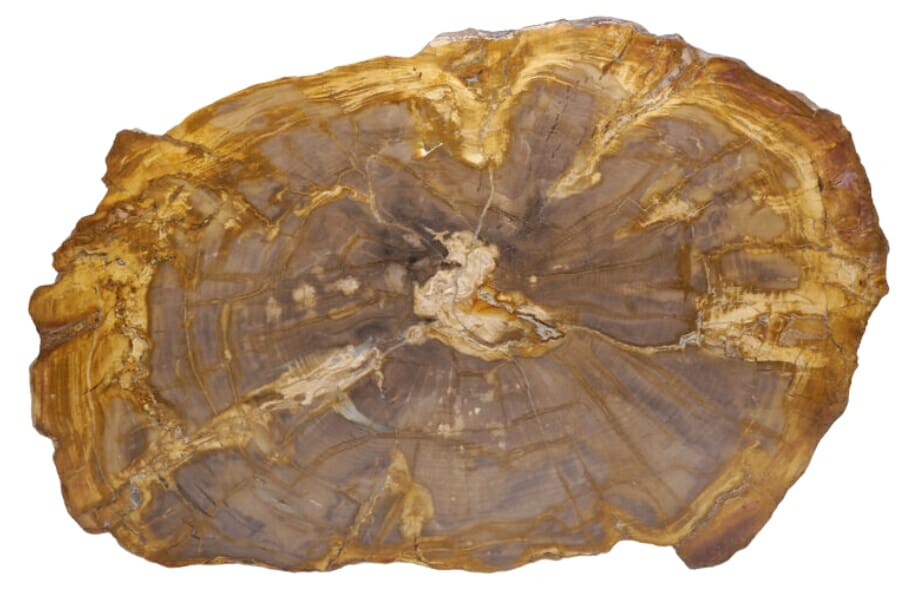
Before we get into the specific places you should be looking we wanted to give you some more general advice. Once you get to your hunting area you should head straight for these areas if you want to have the best results:
Lakeshores
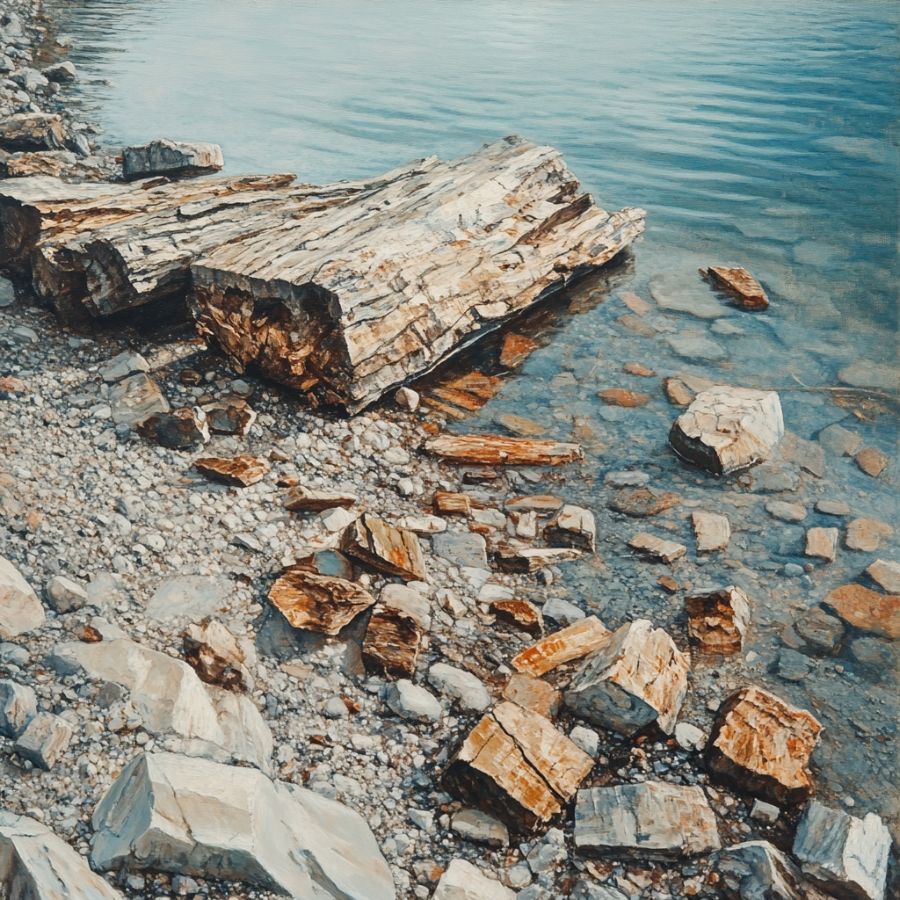
Lakeshores are like natural garbage cans because all things wash up and get left there over time. That includes wood that has turned to stone. As the water rises and falls, it carries sediment and rocks. It also takes the fossilized remains of trees from long ago.
Most lakeshores have a variety of rocks and minerals, which makes them an excellent place for petrified wood to grow and thrive. You’ll find a nice mix of sedimentary and volcanic rocks, the best sites for preserving wood fossils.
Roadcuts
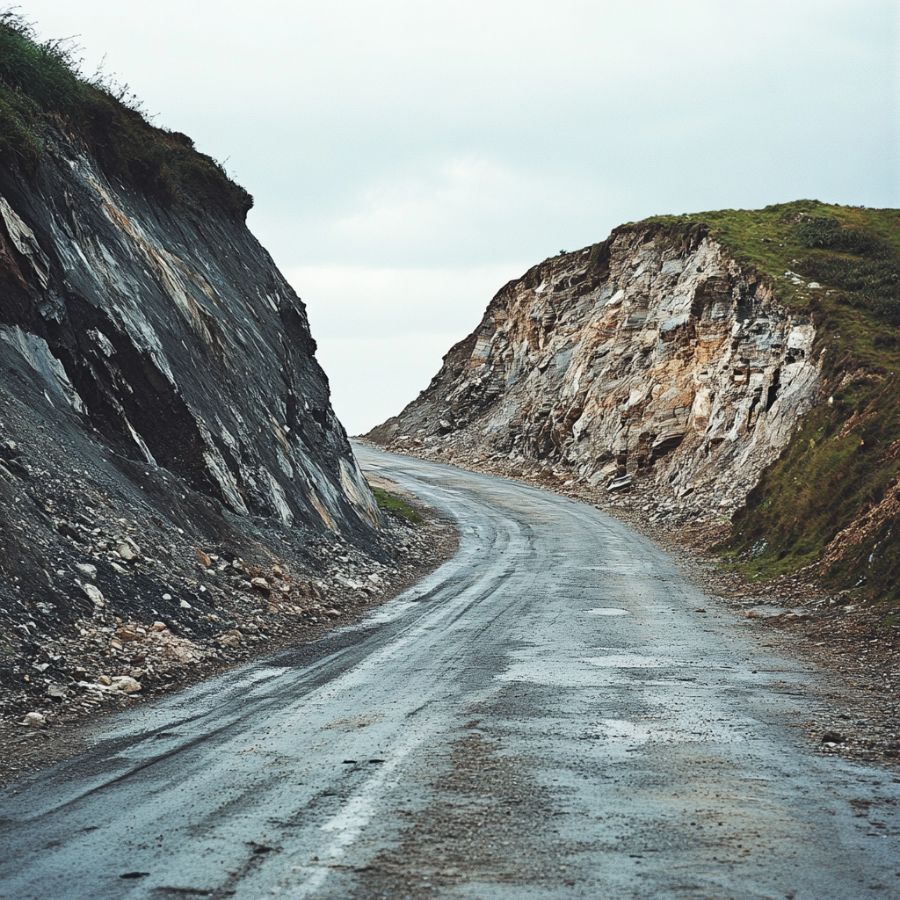
When building roads, parts of the ground are often cut away to make a smooth path. The magic happens when the road cuts through layers of rock and soil. Petrified wood is often buried deep underground, and roadcuts let us see these underground wonders.
As workers blast through the rock layers, they accidentally find petrified wood that has been there for hundreds of years. Petrified wood is easy for collectors to spot because the exposed rock layers of roadcuts make it easy to see its unique patterns and colors.
Streams and creeks
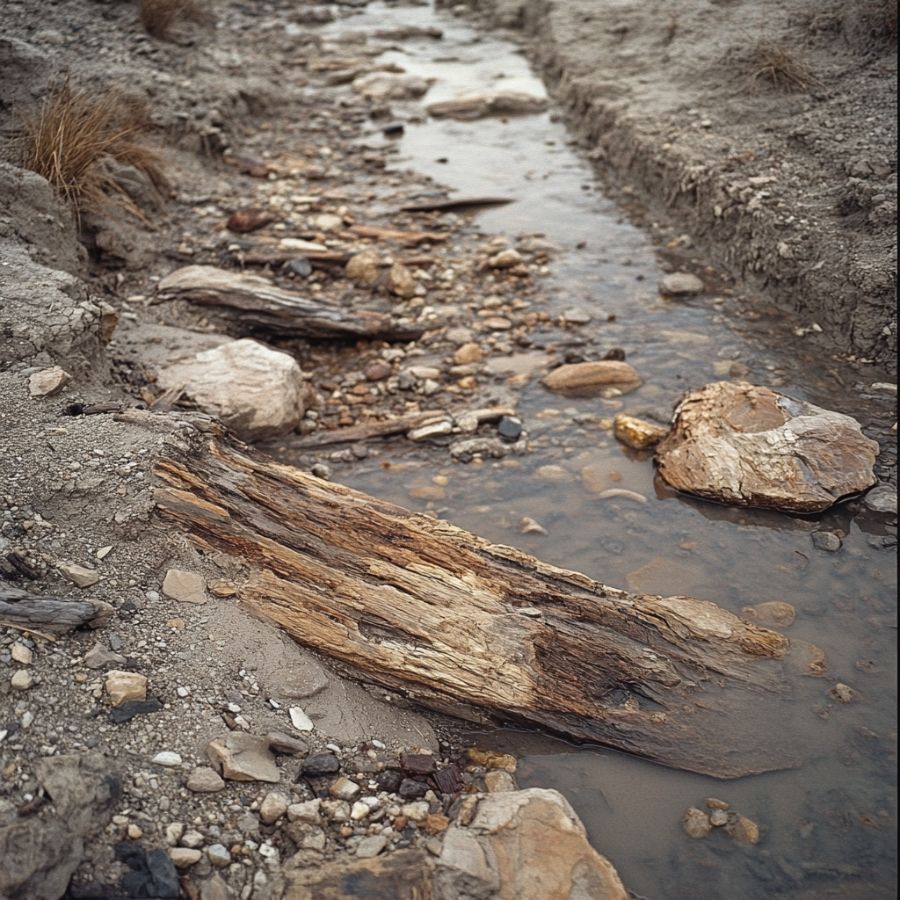
Streams and creeks can move loose sediment away, which can reveal old wood that has turned to stone. As the water moves around, it exposes small pieces or even more significant amounts of petrified wood that have settled on the streambed.
Streams and creeks are more accessible for collectors because they are not as big. You can easily walk along their banks, jump from rock to rock, and look for petrified wood at the water’s edge.
River beds
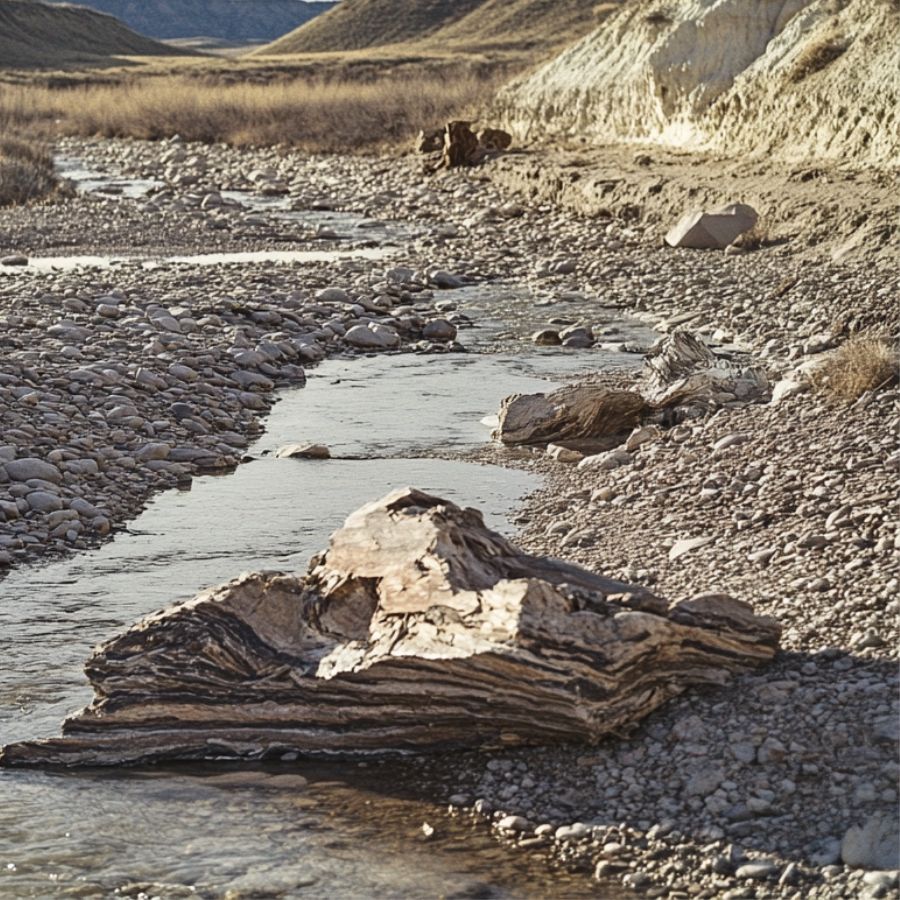
Riverbeds are excellent for finding petrified wood due to their unique geological and environmental conditions. Rapid burial by sediments like sand, silt, and mud protects fallen trees from decay, initiating the fossilization process.
Mineral-rich waters flowing through rivers facilitate the replacement of organic material with minerals such as silica, turning wood into stone. Over time, erosion exposes these buried treasures, making them accessible for discovery.
This dynamic environment, with constant sediment deposition and mineral infiltration, creates ideal conditions for the formation and eventual exposure of petrified wood.
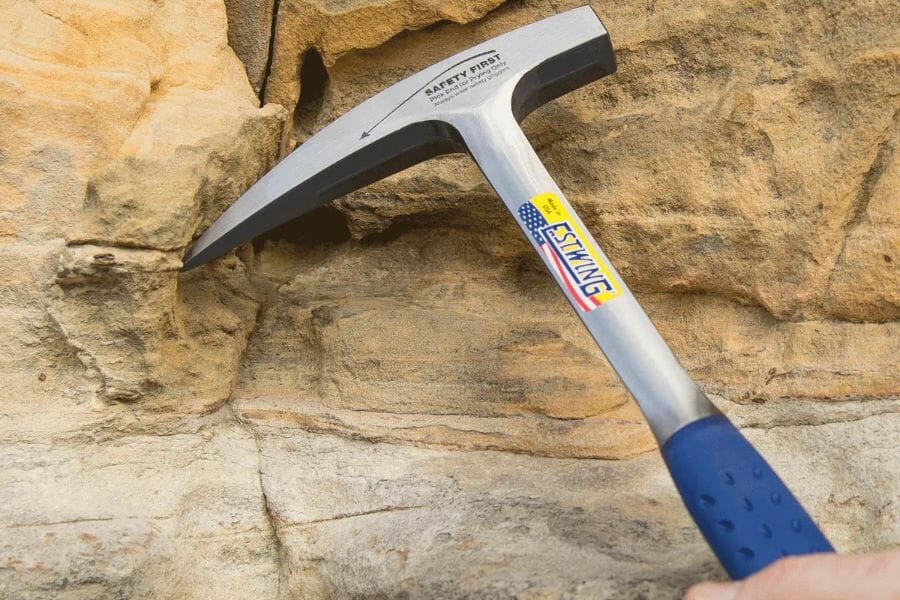
The tools every petrified wood hunter will need
When you're out looking for petrified wood having the right tools for the job is really going to make or break your success. You don't need a lot for most trips but there are a handful that are critical and will make your life a lot easier.
We get asked a lot about the equipment we use. Over the years we've found a handful of tools that we recommend to both new and experienced petrified wood hunters which we outline in great detail in our complete rockhounding tools and kit guide. These are quality options that also happen to be relatively inexpensive.
Below are the basic tools that make your life so much easier and save you a ton of time. Check out the full guide to see everything we recommend bringing. One quick note, as an Amazon Associate I earn from qualifying purchases but we try very hard to only recommend gear we would use ourselves and often recommend brands you can't find on Amazon.
At a minimum you should have:
1 - Sturdy rock hammer: The Estwing Rock Pick is our standard
2 - Rugged chisels: Try Kendo' 3-piece Chisel Set
3 - Compact shovel: The Koleiya 28-inch shovel works well
4 - Rock screen pan: The Wazakura Soil Sieve Set fits the bill
5 - Eye protection: DeWalt Safety Glasses are cheap and comfortable
6 - Head protection: Malta's Safety Helmet has been our go-to
7 - Jewelers lens with at least 20x magnification: Jarlink's Jewelers Loop is perfect
The petrified wood-finding books that we use most
There are also a few books that have been extremely helpful in the search for gems. These books have great recommendations and tips:
National Audubon Society Field Guide to Rocks and Minerals: North America
Southwest Treasure Hunter's Gem & Mineral Guide
Earth Treasures: The Southwestern Quadrant
We provide links to find these tools on Amazon but some can also be found at your local hardware stores. For more recommendations check out the link to our full tool guide above.
The Best Places To Find Petrified Wood In South Dakota
If you’re into rockhounding in South Dakota, you’re in for a treat! South Dakota, with its vast landscapes and rich geology, is a haven for finding petrified wood.
Dive into this guide and discover the top spots where these ancient treasures are waiting just for you!
Always Confirm Access and Collection Rules!
Before heading out to any of the locations on our list you need to confirm access requirements and collection rules for both public and private locations directly with the location. We haven’t personally verified every location and the access requirements and collection rules often change without notice.
Many of the locations we mention will not allow collecting but are still great places for those who love to find beautiful rocks and minerals in the wild without keeping them. We also can’t guarantee you will find anything in these locations since they are constantly changing.
Always get updated information directly from the source ahead of time to ensure responsible rockhounding. If you want even more current options it’s always a good idea to contact local rock and mineral clubs and groups
Black Hills Petrified Forest
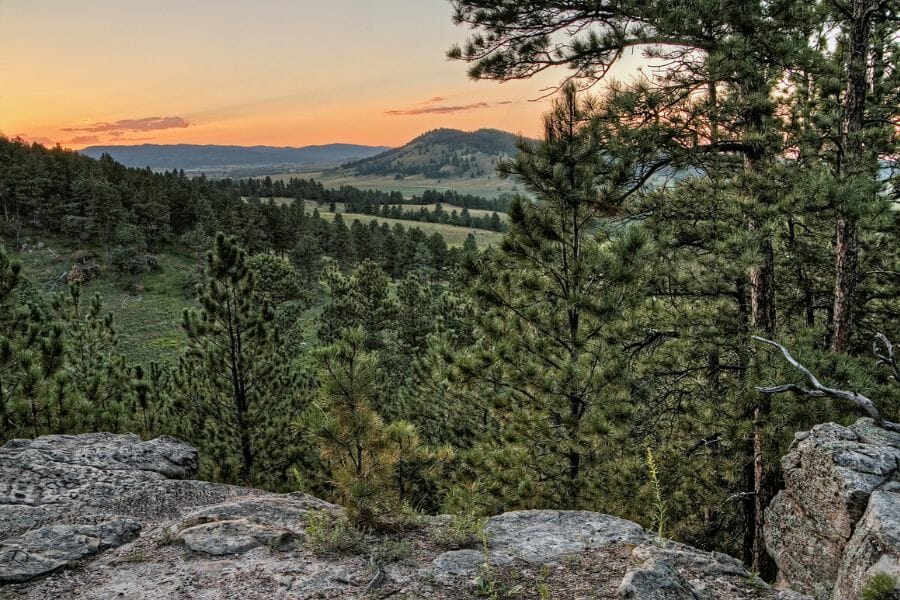
If you’re curious about how to find petrified wood, South Dakota’s Black Hills region is a great place to start your search! This area is known for its rolling hills, rugged terrain, and dense forests.
The petrified forest lies in this unique landscape, and it’s like taking a step back in time.
Here, you can find petrified wood that’s millions of years old. The geology of the place is just amazing! Long ago, trees fell and were buried under layers of mud and volcanic ash.
Over time, minerals replaced the wood, turning it into stone while keeping its original shape. You can still see details like tree rings and bark patterns.
Getting to the Black Hills Petrified Forest isn’t too tricky. The main highways and roads lead you close to the area, and local signs guide you the rest of the way.
There might be some rough paths, so it’s best to check the local conditions before you go.
Once you’re there, you can explore trails and pathways, and if you’re lucky, you might even spot some petrified wood on the ground.
The mix of history, geology, and natural beauty makes the Black Hills Petrified Forest a special place for anyone who loves rocks and the stories they tell!
It’s also important to remember that different areas have different rockhounding rules and regulations.
Make sure to check in with the Bureau of Land Management South Dakota Field Office to make sure that everything you plan to do is aboveboard.
Where we found petrified wood in the Black Hills Petrified Forest
Nestled within the scenic Black Hills, this forest is filled with the remains of ancient trees turned to stone over millions of years.
As you walk the trails, you’ll come across petrified logs, some lying on the ground, and others still rooted in their original places.
These stone trees retain details like tree rings and bark textures. Keep your eyes open, especially near eroded areas and streambeds.
With every step, you’re walking on ancient history, and you might just stumble upon a piece of petrified wood waiting to be admired!
Petrified Wood Park and Museum
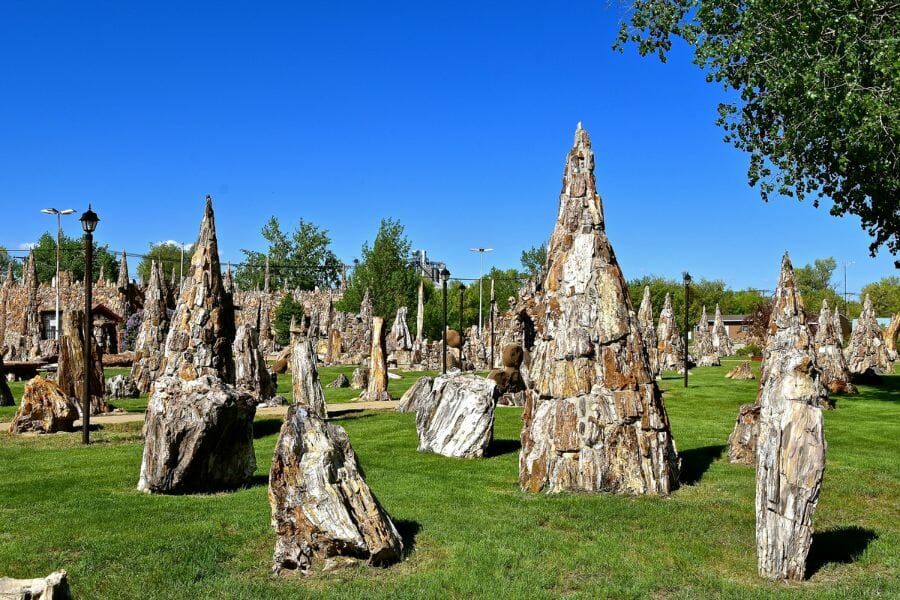
The Petrified Wood Park and Museum is a hidden gem in Lemmon, South Dakota. It’s in the northwest part of the state, not far from the border with North Dakota.
The park is unique with its towers, walls, and displays made entirely of petrified wood, fossils, and other local stones. These formations tell the tale of an ancient past when the area was home to lush forests.
Geologically, the park showcases the incredible process of wood turning into stone. Minerals seeped into the buried wood over millions of years, preserving them as petrified pieces. Many of these pieces are proudly displayed in the park.
The terrain of the park is pretty flat, making it easy for visitors of all ages to walk around and explore. There are paths and walkways that take you to different sections where you can see intricate designs made from petrified wood.
Reaching the Petrified Wood Park and Museum is straightforward. Lemmon is well-connected by roads, so you can drive up there without a hitch.
Once you’re in town, local signs will guide you straight to the park. It’s a great spot for families, rock lovers, or anyone curious about the ancient past of our planet!
Where we found petrified wood at the Petrified Wood Park and Museum
Petrified Wood Park and Museum in Lemmon, South Dakota, is a wonderland for anyone keen on ancient trees turned to stone. Inside the park, you’ll see petrified wood everywhere! There are tall towers and walls built entirely of these stone logs.
As you explore, you’ll also find walkways lined with chunks of petrified wood. The museum adds to the experience, showcasing smaller pieces and giving insights into their history.
Fall River County
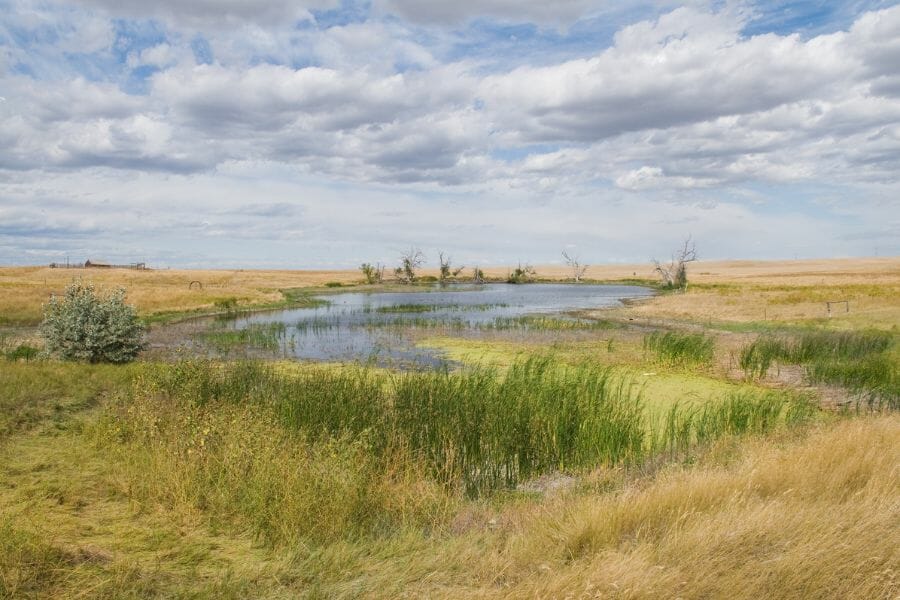
Fall River County is a captivating spot in South Dakota! Located in the southern part of the state, it’s a region filled with diverse landscapes. You’ll see a mix of rolling prairies, rugged hills, and serene river valleys.
The Cheyenne River flows gracefully here, carving its path and shaping the land.
Geologically, Fall River County is a goldmine of stories. It boasts fascinating rock formations and mineral deposits that tell tales of ancient seas, volcanic activities, and age-old erosions. Rockhounds and geology buffs will find a lot to love!
The terrain varies, offering something for everyone. There are flatlands, ideal for casual walks, and more challenging areas for those seeking a bit of adventure.
The county’s natural beauty is a treat for the eyes, making it a favorite for both locals and visitors.
Getting to Fall River County is a breeze. Major highways and roads lead you right to the heart of this scenic area. Whether you’re driving from a nearby town or coming from farther away, the journey is straightforward.
Once you arrive, you’ll be ready to explore and discover the geological wonders and natural beauty that make Fall River County a standout spot in South Dakota!
Where we found petrified wood in Fall River County
Head 7 miles east on a side road to the Flemming Ranch in Ardmore. From there, go east-southeast about 4 miles until you reach an area of breaks right on the Nebraska border.
The Fall River Canyon in the Hot Springs area is also the place to be.
Travel about 2 miles south of the Minnekahta area and look for a broad flat area. You can search for South Dakota petrified wood here and in the nearby hills. Parker Peak is also a great area for petrified wood.
Meanwhile, the Oelrichs area has several routes that lead to great finds. Look in breaks and buttes, and you might just find some pieces of petrified wood.
Buffalo Gap National Grasslands
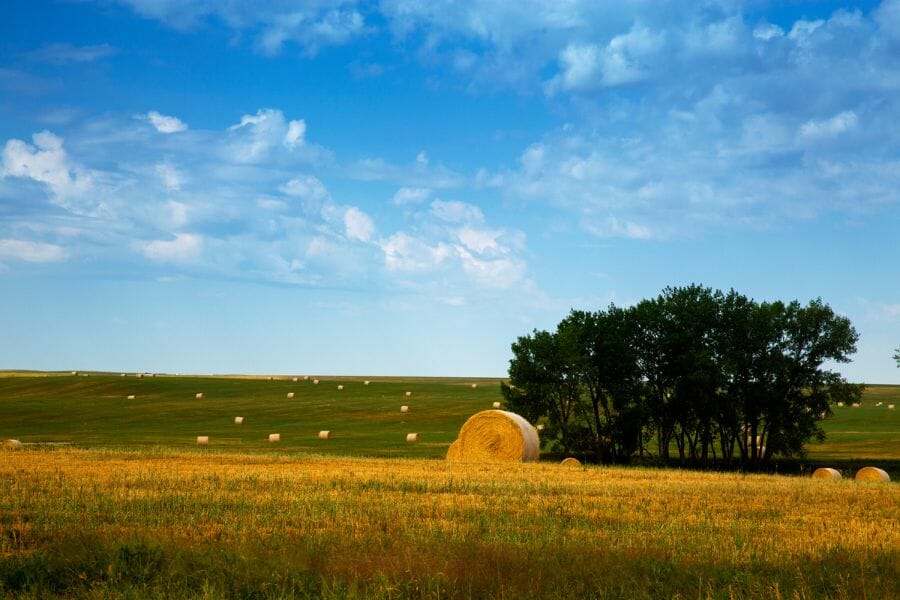
Buffalo Gap National Grasslands is a vast open space in South Dakota, spanning over 600,000 acres! It’s a landscape filled with rolling prairies, rugged canyons, and unique rock formations.
If you love wide-open spaces, this is a place you’ll want to explore.
Geologically speaking, the area boasts a rich history. The rocks and formations you’ll see have been shaped over millions of years. They hold tales of ancient seas, river valleys, and the force of erosion by wind and water.
As you roam, you might even stumble upon fossils that reveal the animals that once lived here.
The terrain is diverse. While there are flat grassy areas perfect for a leisurely stroll, there are also challenging terrains for those looking for a bit more adventure.
It’s a dream spot for rockhounds, with a chance to find fascinating minerals and petrified wood.
Getting to Buffalo Gap National Grasslands is a breeze. Major roads lead to this gem, making it accessible for families, solo travelers, and everyone in between.
Where we found petrified wood at the Buffalo Gap National Grasslands
Rockhounds and nature lovers can spot chunks of this wood-turned-stone scattered across the grasslands. While walking the trails or exploring the canyons, keep your eyes peeled for pieces of petrified wood.
Badlands National Park
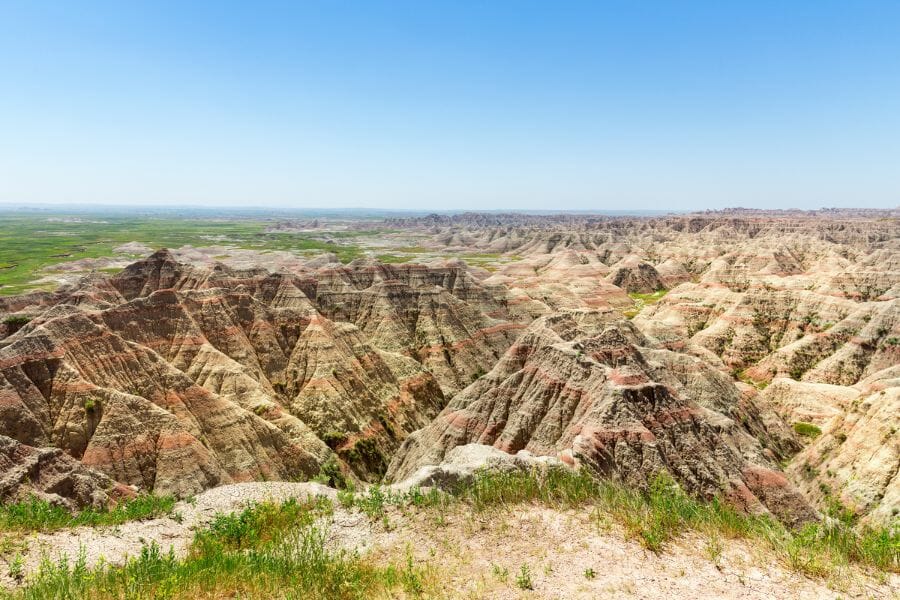
Badlands National Park in South Dakota is a jaw-dropping wonderland! Located in the southwestern part of the state, it showcases 244,000 acres of unique landscapes that seem out of this world.
These lands are a colorful mix of deep canyons, towering spires, and layered rock formations.
The terrain varies from rugged cliffs to rolling prairies. As you wander, you’ll come across the park’s showstoppers: the Badlands themselves. These eroded pinnacles and buttes display a rainbow of colors, from soft pinks to deep reds.
Geologically, the park is a storyteller. The layered rock tells tales of ancient times, revealing Earth’s history over millions of years. Fossils of ancient horses, rhinos, and other creatures provide clues about life long ago.
The Badlands National Park is easily accessible and well-connected by major roads. Just hop on I-90, and you’ll find exits that lead you straight to the park’s main attractions.
Whether you’re traveling from a city or a quaint town, the routes are straightforward.
Where we found petrified wood at the Badlands National Park
As you explore, focus on areas where erosion has revealed the park’s deeper layers. The Sage Creek Wilderness area is a popular spot. Here, amidst the colorful, layered rocks, you’ll spot pieces of wood that turned to stone over time.
Other Great Places To Find South Dakota Petrified Wood
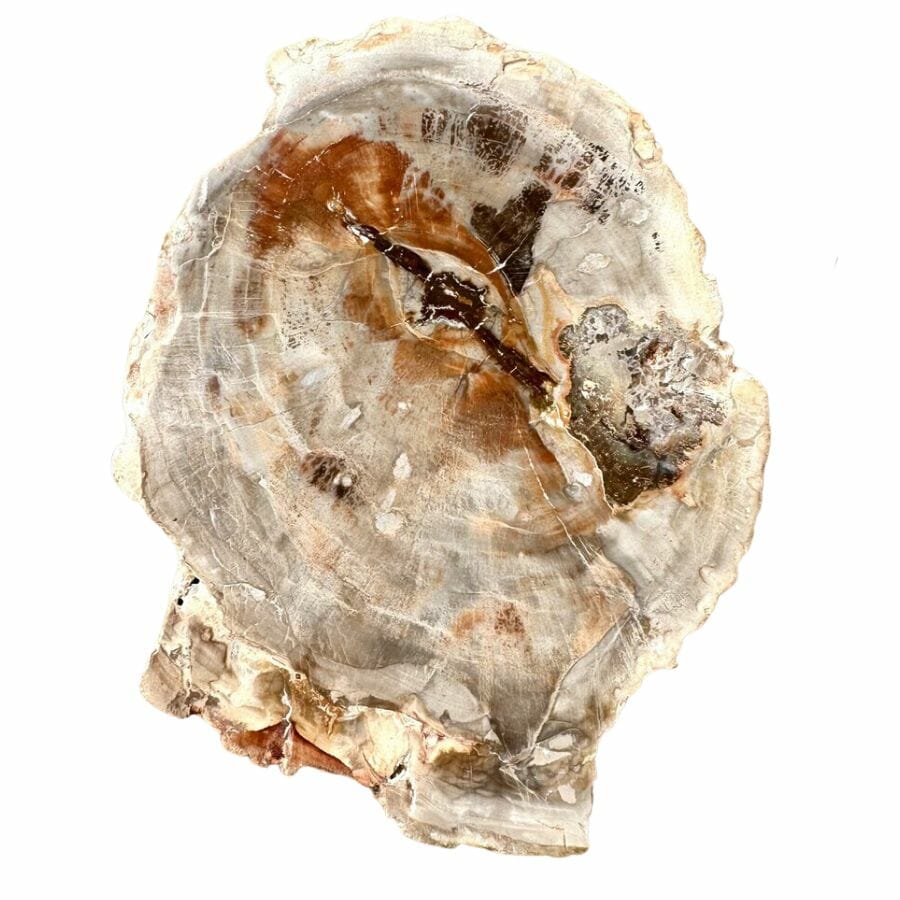
Let’s explore the other spots in South Dakota where you can uncover pieces of petrified wood:
| County | Location |
| Butte County | Look for the Belle Fourche Reservoir, then travel 3.5 miles north on gravel road to Stony Point |
| Butte County | Shoreline of Belle Fourche Dam in the Nisland area |
| Campbell County | Hillsides, ridges, cut banks, tributary gravels in Mound City |
| Corson County | Ridges, slopes, stream beds, and more in Little Eagle |
| Corson County | Banks and gravels along the Grand River in Little Eagle |
| Custer County | Paths going to the Fairburn Agate Beds in the Fairburn area |
| Meade County | Piedmont |
| Mellette County | Corn Creek |
| Pennington County | Eroded areas in Scenic |
| Pennington County | Corral Draw in Scenic |
| Perkins County | Lemmon |
| Todd County | Banks and surrounding hillsides of the Little White River in the Parmelee area |
| Todd County | Banks of the Little White River in the Mission area |
Common Questions About Finding Petrified Wood In South Dakota
These are the answers to questions that people usually ask about South Dakota:
How old is petrified wood in South Dakota?
Within the early Cretaceous Lakota Sandstone deposits, which outline the Black Hills, you’ll find some of South Dakota’s oldest petrified wood. These incredible pieces date back an astonishing 120 to 130 million years!
When you pick up a piece of this petrified wood, you’re holding a relic from an era when dinosaurs roamed the Earth. The colors and patterns in each fragment tell stories of the conditions and climates of that distant time.
Can you find petrified palm wood in South Dakota?
Petrified palm wood is an exciting find for any rockhound! However, when it comes to South Dakota, you won’t typically find petrified palm wood.
South Dakota’s geology primarily preserves wood from ancient coniferous trees and other types of vegetation that existed in the region millions of years ago during the Late Cretaceous Period.
During this time, South Dakota’s climate and environment were different from the tropical regions where palm trees thrive.
If you’re hoping to find petrified palm wood, you might have better luck in states like Texas or Louisiana. These areas were once covered by ancient coastlines and had conditions favorable for palm trees.
The Best Places To Buy Petrified Wood In South Dakota
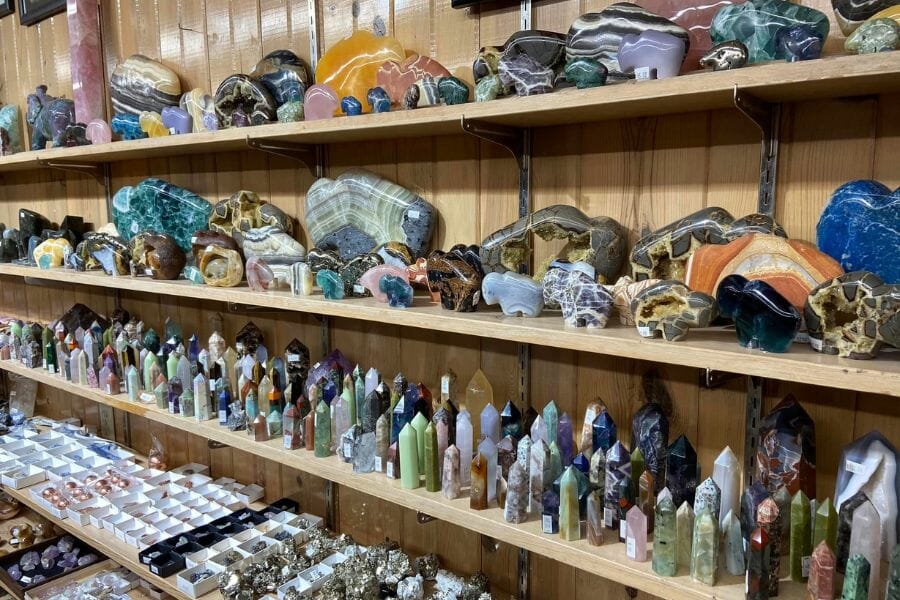
South Dakota boasts some top-notch spots for enthusiasts and collectors to purchase petrified wood pieces. Here are our top picks:
- The Rock Shed – 515 1st St, Keystone, SD 57751
- Ken’s Minerals & Trading Post – 12372 US-16, Custer, SD 57730
- Indigo Iris Rocks and Stones – 7275 Mt Rushmore Rd, Rapid City, SD 57702
- Dakota Stone’s Rock Shop – 23863 Palmer Gulch Road, Hill City, SD 57745
- Whitaker’s Rock Shop – 27162 Wind Cave Rd, Hot Springs, SD 57747

